|
A brief
history of Seaview's design & filming.
Pre-production on the movie Voyage to the
Bottom of the Sea was rolling in late summer, 1960, at
which point Fox's supervising art director, Jack Martin Smith became involved
with the film, and inevitably, the design of Seaview, the mini sub, interior
sets, etc. Since Voyage was to be a science fiction film
based in fact, Seaview's design had to be believable, yet something beyond
the well-known state-of-the-art teardrop shape American submarines had
evolved to. In addition to Smith, staff artist Herman Bluementhal
and to a lesser extent, Fox's effects wizard L.B. Abbott were involved
in the design process. Numerous meetings were held with Irwin Allen,
script in hand, to determine precisely what could and would be depicted
in the film given the available technology and just as importantly, the
available budget.
|
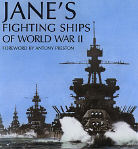
Research Tool.
|
|
Since Jack Smith's tenure at
MGM and Fox had, over the years involved him with numerous movies
featuring ships and even submarines, he was well prepped for
the endeavor. He refreshed his memory by revisiting Jane's Fighting Ships
and touring a nuclear submarine then harbored in San Diego. As he explained
to Tim |
|
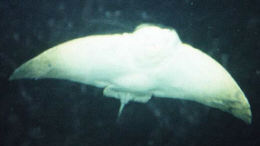
Something fishy? A familiar looking
shape.
|
| Colliver in an interview conducted around
1980, his research was widespread and drawn as well from books on
the anatomy of flowers and fish and the work of Jacques
Cousteau. |
Seaview's intended on-screen length has been bandied about over the years,
and certainly the principals involved in her creation cannot agree.
Jack Martin Smith recalled in a 1980 interview that Seaview was supposed
to be around 300 feet long (highly improbable.) L.B. Abbott recorded,
in his book, Special Effects, Wire, Tape and Rubber Band Style, that Seaview
was "presumably 350 feet long, utterly unique in design, and visually
exciting (regards the length, equally improbable.) The actual blueprints
generated by 20th Century Fox's design department and dated
1960 boldly measure Seaview's length as 400 feet exactly, yet publicity
for the film upon release, site Seaview as longer than two football fields
placed end to end—around 620 feet. This last figure is certainly
the most likely given the expanse of the submarine's interior. It
is also the figure sited in the July, 1966 issue of American Cinematographer
in an article detailing Voyage's deserved Emmy win
for special effects. Again, it is the figure sited in Fox's huge
press package put together in 1968 for Voyage's entry into the
syndication market. In addition, the figure fits nicely with the
length of the Soviet Akula class submarine, which Tom Clancy refers to
as "The world's biggest submarine, pure and simple." at 560.9
feet long. We can only assume Clancy's research hadn't uncovered
Seaview's top-secret existence.
| The first designs to surface
(no pun intended--really) resembled a typical teardrop shaped
submarine with a large glass-domed observation room aft of the
conning tower, presumably similar to the craft depicted on the cover of
the 1961 Bantam release of Theodore Sturgeon's adaptation
of Charles Bennett's script. This design was shelved duo to
budget limitations. Eventually, the familiar manta-ray nose fins and
"glass-nosed" front end design evolved. Initially, the two levels of nose
ports were intended to have six window groupings each, for a total
of twelve. Once again, budget came into play and the number was reduced
to the now-familiar 8 |
|

Original intended
design? Click
here for more. | nose
ports. As Tim Colliver reports in his book, Seaview, The
Making of Voyage to the Bottom of the Sea, "to the rear, two large tail
fins protruded above a pair of exhaust tubes that contained propellers.
The sub had no keel or rudders at this point, but did have missile
hatches, a conning tower with triangular diving planes, a sonar dome at
the top of the hull just in back of the nose, and a hatch under what would
be the missile room section for launching of a mini-sub.
|
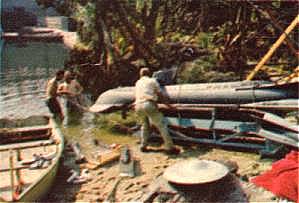
The Largest Seaview Model about to set
sail.
|
|
L.B. Abbott recalled the actual models
of Seaview used in filming as being variously 4, 8 and 19
feet long. The July, 1965 issue of American Cinematographer
says there were 2, 4, 8 and 18 foot models. The usual
length reported for the largest model is either a little over 17
feet or 18 feet long. Upon it's sale by Profiles
in History, the largest model was specifically sited as being
17 feet, 3 inches long. You get the idea. It
was big, and was used primarily for surface shots where water
is subject to surface tension, which means that the bigger the
model, the more realistic will be the final
shot. |
| Even so, slow-motion photography
(shooting the film at ahigher speed than it will be
projected) must be employed to preserve the illusion of model
versus wave size.
For more on the various Seaview effects models, check out Rick
Quizenberry's page. |
| Once again quoting
American Cinematographer, "The size of the waves in relation to
the miniature must be realistic, but those in the background
must gradually diminish in size--a forced perspective, so
to speak. Mechanically, this illusion is achieved
by setting the front wave scale with wind machines,
accompanied by the use of (wave making) plank agitators manipulated by
experienced effects technicians who vary | |
|
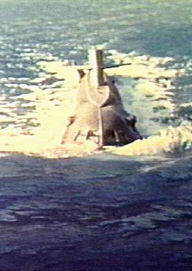 |
|
the cadence to produce an irregular
wave pattern. Large mechanical agitators enhance
the illusion by adding a ground swell."
In the photo at left, note the very diminishment of apparent
wave size described. It was this attention to detail
which made Voyage's most successful surface shots
so convincing. By the time the Voyage series
was shot, the huge new Fox Sersen Lake built for Cleopatera
was available. |
|
|
Underwater photography was created in what was commonly referred
to as "the moat" a huge outdoor shooting tank which was divided in
half for budgetary reasons, rendering a
|
| tank 60 by 60 by 11 feet deep. For
underwater shots, wires were stretched across the usable tank
area. These wires supported silk diffuser. As Abbott put it,
"This allowed us to use diffused sunlight for many of the miniature
shots, making it possible to depict the submarine at great depths
without having the surface water make shadow patterns such as one
sees in a swimming pool. An open-topped camera "barge" was used
which allowed camera and crew to film below the water line and still
be moved about for different shots. The convex underwater ports used
to shoot the footage through were obtained from Disney, and were in
fact, the same ports that Twenty Thousand Leagues Under the
Sea
had been shot through. Such convex ports were needed to
counter the refraction index of water and make the models look
normal, rather than magnified. |
|
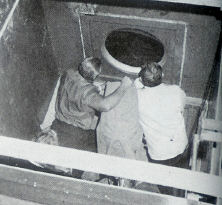
| Looking down on L.B. Abbott and Irwin
Allen.
Glass Port is the same one through which 20,000 Leagues Under
the Sea was shot. |
|
A separate "barge" of different
design was used to create the shots of water burbling up in front of
Seaview's nose ports. The film footage was shot through two quarter-inch
Plexiglass windows in front. As the barge was pulled through the water,
it's forward bevel pushed the structure deeper into the water. The speed
at which the barge was pulled, controlled it's depth, and a special fan
shaped nozzle fed by a high-pressure water pump increased the agitation of
the water, which was shot from within at high speed. Projected back onto
the nose set's rear projection screens at normal speed, the footage gave
the illusion of surfacing, running and submerging as seen from inside the
sub.
The 8 foot model was used for most underwater
shots, where the problem of surface waves and droplet size were not
an issue. As reported in the July, 1966 American Cinematographer, the
models were pulled by fine piano wire which was invisible on
film when carefully lit. For the scene where the generic UN teardrop sub
chasing Seaview imploded, the models were guided thusly, and the explosion
accomplished by an internally placed explosive charge. There was no
computer animation at the time and it wasn't needed to created incredibly
realistic undersea shots and, in addition, underwater explosions.
All of the Voyage movie's surface
shots were filmed in Fox's original Sersen Lake built for 1939's
The Rains Came. Voyage was the last film shot at this
facility before the land was sold for the development which became known
as Century City. |

